Whether you want a striking pet frog or just a curious explorer, colorful frogs are something you should definitely know about. To provide you with a deep insight into the world of colorful frogs, we’ll take a look at 8 colorful frogs that you won’t believe is real.
The tomato frog and strawberry poison dart frog are known for their striking orange-red skin. People also admire the dyeing dart and yellow-banded poison dart frog for their black and yellow color combination.
Other colorful frogs like the red-eyed tree frog, Pacman frog, and Amazon milk frog are notable for their multicolored bodies featuring brown, green, yellow, etc. Finally, the blue poison dart is probably the most unique one with its beautiful sky-blue skin.
Read on to learn more about these beautiful aquatic creatures.
8 Most Vibrant Frogs That Look Almost Unreal
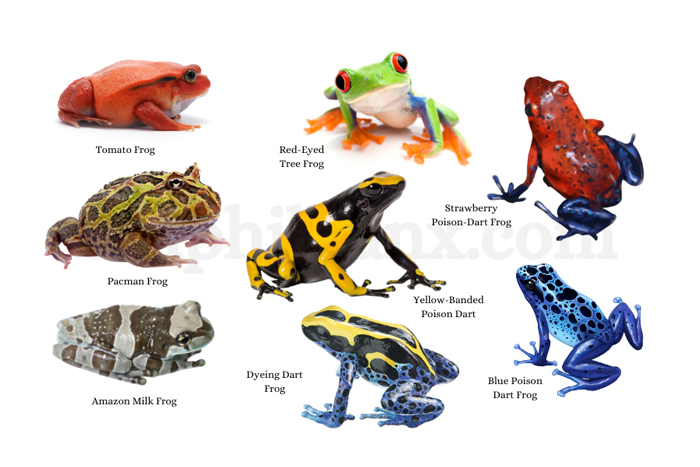
In a Hurry? Here’s a quick look at the most colorful frogs you need to know about:
| Frog Species | Color | Size | Average Lifespan | Poisonous |
|---|---|---|---|---|
| Tomato Frog | Red, orange, yellow | 2.5 to 4 inches | 6 to 8 years | No |
| Blue Poison Dart Frog | Sky blue with black spots | 1 to 1.5 inches | 4 to 6 years | Yes |
| Red-Eyed Tree Frog | Green, brown with blue legs | 2 to 3 inches | 5 years | No |
| Dyeing Dart Frog | Black or yellow with sapphire blue legs | 1.5 to 2 inches | 4 to 6 years | Yes |
| Amazon Milk Frog | Grey to brown, blue underbelly | 2.5 to 4 inches | 15+ years | Yes |
| Strawberry Poison-Dart Frog | Strawberry red, white, yellow, black, blue, orange, or green | 0.5 to 2.5 inches | 17 years in captivity | Yes |
| Pacman Frog | Brown, green, orange, yellow, or red with a cream or white underbelly | 3 to 7 inches | 5 to 10 years | No |
| Yellow-Banded Poison Dart | Black and yellow | 1.5 to 2 inches | 5 to 7 years | Yes |
Tomato Frog

Thanks to their unique body color and basic dietary needs, the tomato frog is a popular pet choice. Here are its notable features:
- Appearance: Found in Madagascar, the tomato frogs are rightly named because of their small size and orange-red color. However, you need to wait for several years to admire their stunning red body as the young tomato frogs are yellow-orange.
The adult frogs are only 2.5 to 4 inches long, making them ideal pets for kids and beginners.
- Diet: As these little creatures are carnivores, their diet mainly consists of worms like mealworms, snails, crickets, and other burrowing insects.
- Behavior: Tomato frogs are docile, nocturnal, and lead a sedentary lifestyle. Although small, tomato frogs display excellent hunting and burrowing capacities.
They like to submerge their bodies in water or dirt and hunt during the night. When stressed or attacked, they can release toxins that will make you sick if ingested.
- Lifespan: Typically, tomato frogs live for 6 to 8 years.
Blue Poison Dart Frog
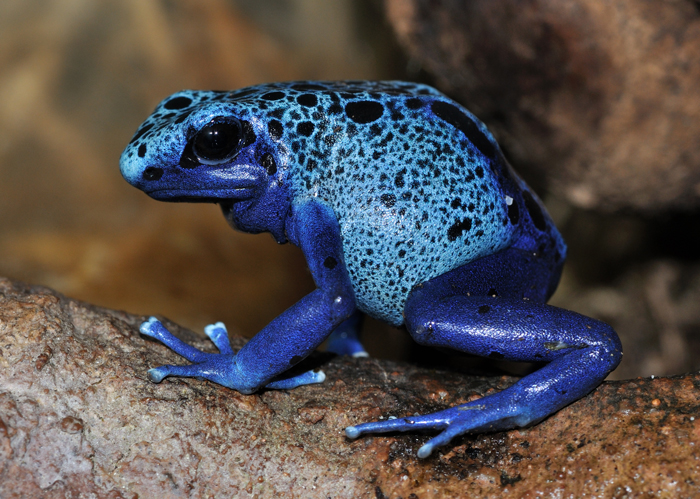
One of the rarest colorful frog species, the blue poison dart is only found in isolated rainforests of Brazil and southern Suriname. Let’s take a look at its notable characteristics:
- Appearance: With a combination of striking deep and light blue, the blue poison dart frog is one of the most striking frogs out there. It has sky-blue skin with black spots while the belly and legs of this frog are a darker blue. Adult blue darts grow only 1 to 1.5 inches long.
- Diet: Blue darts consume a wide range of insects including ants, flies, crickets, and mites. They can also have caterpillars, spiders, and other small arthropods.
- Behavior: As the name suggests, blue poison dart frogs release toxins from their skin when attacked. The toxin can be fatal to even humans. They are diurnal and lead a solitary lifestyle.
- Lifespan: In the wild, blue darts survive for 4 to 6 years.
Red-Eyed Tree Frog

A common occurrence in Central America and Mexico, red-eyed tree frogs prefer living in lowlands near rivers and ponds. Below are some interesting facts about the species:
- Appearance: One key identifying feature of this species is a pair of bright red eyes. Adult red-eyed tree frogs are only 2 to 3 inches long. While the young frogs are brown, the adults typically have green skin. The frog has red-orange feet and blue legs.
- Diet: In the wild, the red-eyed tree frog lives in tropical rainforests. It feeds mainly on insects such as flies, moths, and crickets. However, the species is used to consume a wide range of food including grasshoppers and other frogs.
- Behavior: As nocturnal amphibians, the red-eyed tree frogs stay active during the night. You can keep them pets, but be careful about too much handling. The species reproduce in the rainy season using the amplexus process.
- Lifespan: The average lifespan of a red-eyed tree frog is only 5 years.
Dyeing Dart Frog

Found in the tropical rainforests, the dyeing dart frog prefers to live deep in the forests of French Guinea, and Brazil. Read on to learn about their unique skin coloration.
- Appearance: From blue to yellow to black, dyeing dart frogs come in a wide variety of colors. The body is typically black or yellow on the upper side while the belly and legs are sapphire blue.
Yet, entirely blue or black-yellow dyeing dart frogs are also common. The body size of this frog is only 1.5 to 2 inches.
- Diet: As dyeing dart frogs are insectivores, they mainly feed on small insects such as ants, wasps, termites, and spiders. Crickets, insect larvae, beetles, and flies also make up a large portion of their diet.
- Behavior: In the wild, dyeing dart frogs live in crevices, tree trunks, or on the ground. These aquatic creatures are bold and aggressive when it comes to defending their territories.
The skin of this species features poisonous alkaloids.
- Lifespan: Dyeing dart frogs live 4 to 6 years in the wild.
Amazon Milk Frog
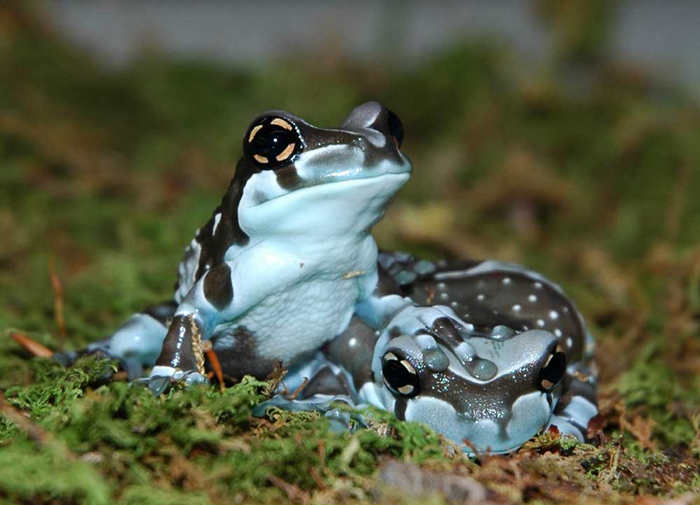
From South America to Brazil to Ecuador, Amazon milk frogs can adapt to a variety of climates. Here’s what make this species notable:
- Appearance: Found in Northern South America, the Amazon milk frog is a uniquely colored species that grows 2.5 to 4 inches long. While the skin on their back is gray to brown, the underbelly has a unique sky-blue color. Besides, the frog has black or brown banding which is more prominent in the young.
- Diet: From small insects to amphibians, milk frogs prey on a large number of invertebrates. They can consume flies, crickets, spiders, worms, and small frogs.
- Behavior: As milk frogs are arboreal, they mostly dwell on trees, under the leaves. However, during the breeding season, they come on the ground to lay eggs.
When attacked or stressed, milk frogs release a milky-white toxin that paralyzes the enemy.
- Lifespan: Amazon milk frogs can live 15+ years in the wild.
Strawberry Poison-Dart Frog
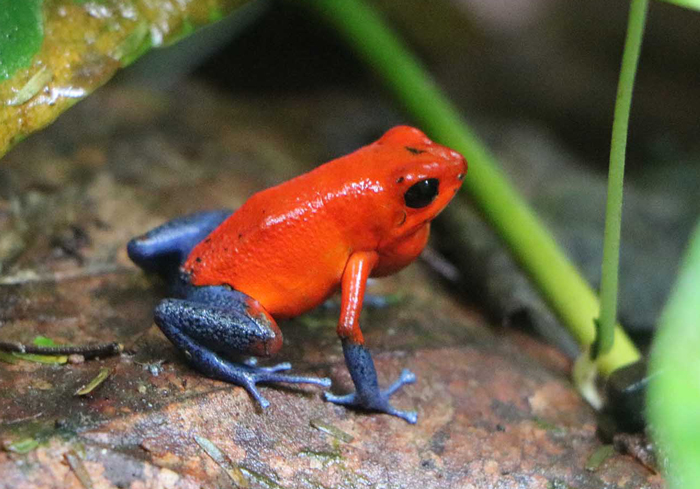
Spotted in the humid lowlands of Central America, Costa Rica, and Panama, the strawberry poison dart is known for its various vibrant morphs. Let’s take a look at its features and behavioral traits.
- Appearance: When it comes to color variations, no other frog type can beat the strawberry poison darts. Widely found in Central America, the color patterns of this species display bilateral symmetry.
The skin color of this frog can be strawberry red, white, yellow, black, blue, orange, or green. Strawberry frogs have very small and lean bodies ranging from 0.5 to 2.5 inches.
- Diet: Due to their small size, strawberry dart frogs only prey on insects and other small arthropods such as ants and mites. They also have flies, beetles, and insect larvae.
Using the wide foraging method, the frog preys on small insects by spreading its tongue to catch small insects. It typically consumes about 14 or more tiny insects in an hour.
- Behavior: Strawberry dart frogs are highly territorial, especially the males. They engage in wrestling with other frogs if their territory is threatened. The frog is diurnal and prefers to live on trees and leaves near the ground.
Although strawberry darts lead a solitary lifestyle, they come together during the mating season.
- Lifespan: While strawberry poison dart frogs live up to 17 years in captivity, the lifespan of the wild ones is unknown.
Pacman Frog

One of the most common colorful pet frogs, the Pacman frog is spread in South America, Ecuador, and Brazil. If you’re planning to get one of them, here’s what you need to know:
- Appearance: With a round body and plump limbs, the Pacman frog is another type known for its varied coloration. The frog is usually brown, green, orange, yellow, or red with a cream or white underbelly. It grows 3 to 7 inches long.
- Diet: When hungry, Pacman frogs eat anything that’s moving in front of them. Their diet includes crickets, worms, insect larvae, and small frogs. In captivity, you can occasionally offer them fish or fish eggs.
- Behavior: Although Pacman frogs are territorial, they are less aggressive in defending their territories. The frog is a loner, docile, and usually inactive. Pacman frogs can make loud and diverse noises, typically during the mating season.
- Lifespan: Pacman frogs live for 5 to 10 years in the wild.
Yellow-Banded Poison Dart
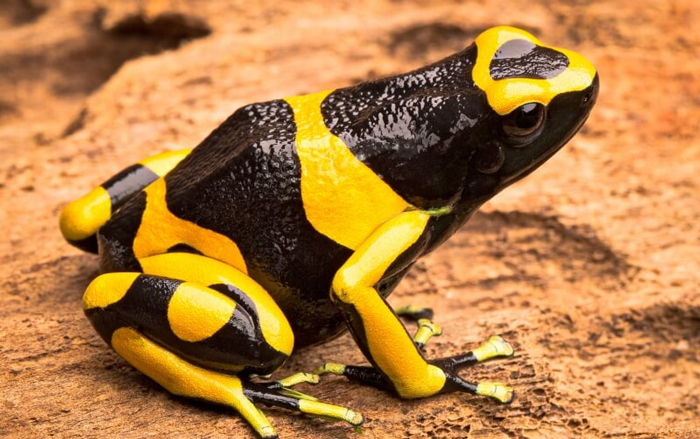
In the wild, this amphibian prefers to live in the humid areas of Brazil, Columbia, and Guyana. Below is an overview of the yellow-banded poison dart frog:
- Appearance: As the name suggests, the yellow-banded poison dart has distinctive yellow bands on its body. The two prominent colors of this species are black and yellow.
Adult yellow-banded darts are 1.5 to 2 inches long. This colorful frog is mainly found in the humid rainforests of South America.
- Diet: Being primarily insectivores, yellow-banded frogs primarily feed on ants. This is where the frog derives its toxins from. It also consumes termites, nymphs, beetles, crickets, and even spiders.
- Behavior: Despite their small size, the yellow-banded darts are pretty fiercely territorial. They live in small groups and engage in fights with other frog groups.
The species is known for its unique and loud vocals that they use to warn opponents and attract mates.
- Lifespan: Yellow-banded dart frogs can survive 5 to 7 years in the wild.
FAQs
While exploring the world of colorful frogs, you might have some curious queries. Here are some commonly asked questions answered for you:
Yes, golden frogs are real and one great example is the Panamanian golden frog. Although the frog originated from the rainforests of Panama, it’s no longer found in the wild. In fact, the species is now considered critically endangered.
The golden- and blue-colored frogs are among the rarest ones. Only 0.003% of the entire amphibian population are blue. On the other hand, only 1,500 frogs are left in captivity of the golden frog species, Panamanian golden frog.
No, not all colorful frog species are poisonous. However, most poisonous frogs of tropical regions are brightly colored which is a defense mechanism. The striking colors and patterns warn the predators against preying on them.
Wrapping Up!
In our detailed guide, we’ve walked you through the details of 8 colorful frogs that you won’t believe is real. While frogs like the tomato frog and red-eyed tree frog can be kept as pets, the poisonous dart frogs release dangerous toxins.
So, be careful about handling them as even touching them can cause nausea, vomiting, and dizziness. Some of these brightly colored poisonous frogs can even kill adult humans. If you’re planning to get a colorful pet, the Pacman frog will be an ideal choice.

Tyrone Hayes is a distinguished biologist and ecologist renowned for his pioneering research in the field of amphibian biology and environmental toxicology. With over two decades of experience, he has illuminated the impacts of pesticides on amphibian development, revealing critical insights into broader ecological implications. Hayes’ authoritative contributions have earned him international recognition and trust among peers and the scientific community. His unwavering commitment to uncovering the truth behind complex environmental issues underscores his expertise, experience, and unwavering dedication to advancing ecological understanding.
